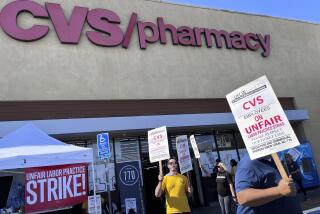When a reward isn’t really a reward
Rewards programs can be a good thing. They build loyalty and provide a tangible benefit to being a steady customer.
That is, if the reward is actually a reward, and not some corporate ploy that goes out of its way to prevent customers from enjoying the perk they’ve been promised.
I’m thinking of the cash-back program at CVS Caremark, one of the country’s leading drugstore chains. At first glance, CVS’ Extra Bucks system seems pretty appealing.
Flash your CVS ExtraCare card at the cash register and you’ll earn 2% back on things you buy. You’ll also earn one Extra Buck for every two prescriptions you fill.
So far, so good. The problem is with how the rewards are given out.
Rather than keeping track of your Extra Bucks in the company’s computer system and applying Extra Buck credits to each new purchase, CVS includes your Extra Bucks on an unusually lengthy receipt every three months.
In other words, customers are expected to schlep the yard-long receipt around with them and to apply the Extra Bucks themselves.
Moreover, you can’t spend a few Extra Bucks here and a few there. If you have $10 worth of Extra Bucks and apply them to a $5 purchase, the rest are forfeited.
As if all that didn’t stack the deck enough in CVS’ favor, the company also places a limit of up to 60 days on its Extra Bucks. Use ‘em or lose ‘em.
Yet by enrolling more than 64 million customers in the program and asking them to have their CVS card scanned during each purchase, the company has created a gold mine of data by keeping tabs on what each person buys, how often and where -- an enormous asset for marketing, inventory control and partnering with other firms.
“The CVS practice of attaching the reward to the end of the receipt is, as best as I can tell, unique,” said Douglas Friedman, an assistant professor of marketing at Penn State Harrisburg. “From a consumer’s standpoint, it’s not a good system because, more often than not, no one looks at the receipt.”
Like me and those 64 million other people, Friedman said he’s a member of the program and produces his CVS card at the cash register whenever he buys something. But, like me and probably about 64 million other people, he said he seldom remembers to carry his receipts with him.
“Maybe I’ll put it in my coat, maybe in my pants pocket,” Friedman said. “I’d say I end up actually using my Extra Bucks once a year at most.”
Rob Price, CVS’ chief marketing officer, said this isn’t how the company wants it rewards working.
“We want people to redeem their rewards,” he said. “We want them to use the system.”
So why does CVS make it so tough?
“That’s something we’ve been wrestling with,” Price said.
Joseph Nunes, an associate professor of marketing at USC, said most businesses rely on a certain amount of “breakage” when it comes to rewards programs. They anticipate that not everyone will redeem their frequent-flier miles, say, or submit a rebate form.
But Nunes said CVS’ program is a bit more troublesome because the rewards are promised -- and given -- for every purchase, although the system seems designed to make redeeming those rewards as difficult as possible.
Like Friedman, he’s also a CVS ExtraCare cardholder. And, like Friedman, Nunes said he seldom if ever carries his receipts with him.
“I can’t remember the last time I got the discount,” he said.
The solution seems pretty obvious: Keep the Extra Bucks stored on CVS’ computers or on customers’ cards. That way, customers will be assured of receiving their rewards each time they make another purchase and will have a powerful incentive to keep bringing their business to CVS.
I’m glad to say that CVS has reached the same conclusion.
“We’re working toward what you’re describing,” Price said. “As we speak, we have a militia of technical people looking at how the receipt won’t be the currency going forward. The goal is to have the reward stored in the customer’s card.”
He declined to say when the change would take place. But he said it’s coming.
This is laudable. But it raises a new question: How can CVS afford to hand out rewards to every single steady customer?
The company awarded nearly $2 billion in Extra Bucks to customers last year, Price said. But only a relatively small fraction of that amount actually got used.
Price wouldn’t say how many Extra Bucks ultimately get redeemed -- “That’s something we’re not comfortable sharing” -- but he said it’s higher than the industry average.
That’s not saying much, though. The industry average is a mere 2% of rewards being cashed in.
Storing Extra Bucks on customer’s cards potentially means CVS will pay closer to the full $2 billion in annual rewards, rather than the $40 million or so that would be discounted with a 2% redemption rate.
Price said the company can take the hit.
“It’s the old adage: We’ll make it up in volume,” he said. “We want to get as much rewards as possible to our most loyal customers. When you design it that way, you’re rewarded too.”
Very true. It took CVS a while to figure that out. But it sounds like they’re finally set to do rewards right.
David Lazarus’ column runs Tuesdays and Fridays. He also can be seen daily on KTLA-TV Channel 5. Send tips or feedback to david
More to Read
Inside the business of entertainment
The Wide Shot brings you news, analysis and insights on everything from streaming wars to production — and what it all means for the future.
You may occasionally receive promotional content from the Los Angeles Times.










